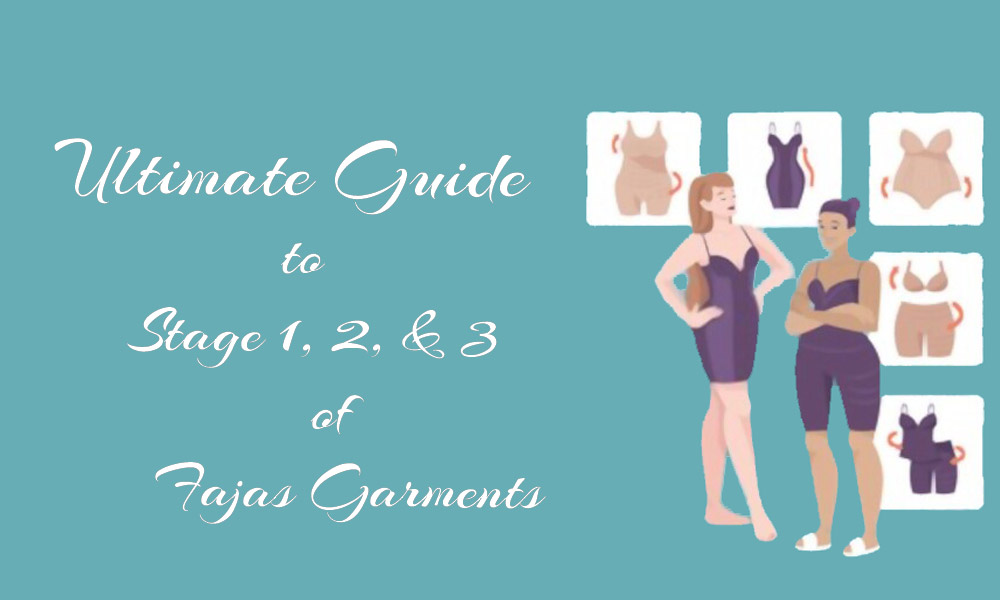No products in the cart.

Ultimate Guide to Stage 1, 2, and 3 of Fajas Garments
So you are searching for information on post-surgery faja compression garments. You keep coming across the term; stage 1 or stage 2 or stage 3 or fajas, and you wonder what all this means? Welcome! You are not alone.
After our write-up on liposuction, we received a flurry of questions and inquiries about compression garments, especially fajas for post-op. Questions- what is stage 2 or 3 compressions? Why do I need a faja? What is a faja?
As you know, we have your back. We have compiled this ultimate guide to answer your most pressing questions on this topic, so sit back, read, get informed and make the best choices for your health and well-being. Remember, the goal is to be in health even as you always look fabulous.
Wondering why, when, or which Stage 1,2,3 Faja compression garments you should wear at all?
Faja is a compression shapewear used for recovery after liposuction, tummy tuck, or BBL patients to heal scars neatly, control the swelling and guarantee that the skin tightens appropriately. With fajas, we are talking severe but comfortable compression levels. The compression level is in three stages: stage 1, stage 2, and stage 3 compression.
A faja or compression garment is required to experience a healthy recovery after liposuction; it lowers the discomfort and enhances outcomes following surgery. You must understand that the Post-Op recovery period is as important as the surgery as well. Nevertheless, we understand your anxiety about the effects or advantages of wearing compression clothing after liposuction.
Here are a few benefits to wearing compression fajas.
- Aids the attaching of flabby skin to the muscle.
- Lessens inflammation in the tissue.
- Reduces the discomfort and agony after liposuction.
- Fluid retention prevention.
- It stops bleeding.
- Sagging is reduced.
- It improves your posture.
- Gives you control and assistance with your recovery.
- Increases circulation and decreases inflammation.
- It contains Vitamin E, which aids in mending and smoothing your skin, therefore preventing scarring.
- Aids the attaching of flabby skin to the muscle.
The sort of surgery you have will decide which post-operative compression garments you will need to wear, i.e., needing stage 1, 2, or 3 fajas. These garments are available in a wide range of sizes and designs to fit various cosmetic treatments. This is why your doctor’s advice is essential hence why they should be in the know on every detail and process of your surgery.
Why Faja Compression Shapewears?
Fajas are intended to aid the body’s recovery by reducing swelling(Oedema) throughout the healing process. After a surgical procedure, many doctors advise wearing a binder for the first two weeks to help control the Oedema and incisions. These garments help you speed up recovery after liposuction, tummy tucks, Brazilian butt lifts (bbl.), and other procedures, as stated earlier.
Medical expert and plastic surgeon Carolina Ruiz discusses why post-surgery fajas are required following treatments like liposuction, tummy tucks, and dermolipectomy.
According to Carolina, “When you introduce the cannula (thin tube) under subcutaneous cellular tissue, you create a hollow space between the aponeurosis and the skin that should not exist. During this procedure, you break certain structures such as lymphatic and blood vessels, which causes bleeding. The girdle compresses the area to reduce that space. If this does not happen, temporary pockets of fluid (seromas) can be formed under the skin. Plus, it is also necessary to reduce bleeding.”
Powernet is commonly used in making post-surgical fajas. This material is a polyamide/elastane blend. This effective mixture comprises a breathable fabric that pulls moisture away from the skin, as a result helping to prevent bacterial infections.
Having said that, Fajas are generally tighter than standard high compression waist trainers; the garment’s inner layer is designed as a delicate material that is gentle on the skin and prevents comfort issues or escalating injuries.
Please note, it is critical to wear a tummy tuck girdle or faja with the appropriate compression level and size to get the desired results from your belly tuck. This is done to avoid Oedema and fluid retention and allow the skin to recover.
It is easy to get confused about the stage 1, 2, or 3 compression garments, so let’s demystify them.
When to Use a Stage 1, 2, or 3 Compression Faja
Stage 1 Compression Faja
This is the Faja you’ll be wearing the moment you wake up after your surgery. 0-2 Weeks Post-Op. Immediately after the surgery, your body will be swollen, sensitive, in intense pain from your surgery, clear from the pain killers, and bloated as well.
At this time, you need mild compression; plus, you will likely be using a compression garment that is a size bigger than what you were wearing before surgery.
Stage 1 compression faja starts to function immediately after the surgery is complete. This goes on for about two weeks, depending on how well your healing progresses. The stage 1 faja has minimal compression, which means it will fit loosely on your body rather than tightly.
The goal of stage 1 faja is to allow your body adequate fluid circulation for complete healing and draining. It is not intended to fit or contour like shapewear or a waist trainer. Please note that fluid is inserted into the body during liposuction or tummy tuck to allow for fat removal. You must have enough room between your body and the faja for this fluid to drain and your delicate skin to begin to heal.
Part of what you begin to notice is- your stage 1 faja feels firm at first but gradually loosens over the first few weeks of healing. Congratulations! It indicates that your body is draining fluids and performing the necessary functions.
A qualified pre-op specialist or doctor will measure your physique to understand the possible changes that will occur following your surgery. Again, before you may wear your new faja, you must be sized to find the best fit for your specific body type. This will take place at your pre-operative visit.
Stage 2 Compression Faja.
Stage 2 Fajas are custom-designed products that can also be worn as waist trainers. This faja begins two weeks after surgery and runs for four weeks ( From Week 2 to Week 6). This faja aids with snatching the tummy, back fat and also sculpting the waist, hips, and midsection depending on where compression is most required.
The significance of stage 2 is light sculpting and plenty shaping up. Yes, your surgeon has done the magic; now the rest depends on you giving yourself a lot of TLC and the use of proper compression to avoid fat bulges or fat balls and bumps.
Stage 2 compression garments provide more intense therapy to match your body’s healing. Your body generally healed during stage 1; the cuts or incisions might have been painfully raw and inconvenient. By stage 2, your body has recovered a bit. Still, it requires firm support yet lighter compression as you gradually return to your daily life. Stage 2 fajas are known to complete the deal for final recovery and delivering the best possible surgical results.
The stage 2 fajas come with high compression tummy control of the abdomen region, sometimes with a zipper closure reinforced with a hook and eye closure. Whether they may or may not come with crotch opening depends on design and function. Before making the purchase, talk to a professional about what you need to ensure you buy the right size and function.
At stages 1 & 2, the compression garments do not come with rods to avoid irritating/pressurizing the cuts or incision points.
Stage 3 Compression Faja.
This stage is 6-12 weeks post-surgery. At this time, your body and the incisions should have healed and almost wholly. This is necessary because these fajas are built with a waist trainer design. They come fitted with rods, latex, and other high compression materials, which significantly increase compression levels.
You are closer to 90% free of swelling and pain-free. You are now more comfortable switching to a tighter and firmer compression. The stage three fajas are necessary to continue to snatch up, shape, and curve your silhouette. Now, you may be ready for more challenging and different garment styles in small sizes that give higher compression.
In addition, it is recommended that you keep the compression constant for the first six weeks at this stage. This is to train your muscles and help you get the evenest shape and silhouette possible from your body.
You now understand what, how, and when to use the different stages of the Faja garment or shapewear. You need two garments per stage – for alternation, bearing in mind that it takes about 4-5 hours for each garment to dry.
For your Stage Three (weeks 6-12), wearing your Post-Op Compression Garment for 12 hours per day will suffice. Don’t hesitate to talk to your physician about whatever concerns you might have pre-op, during-op, and post-op. Also, as soon as you can, back up your surgery with a healthy lifestyle to make sure the surgery effects stay permanent. Good luck!







Yecenia sanz
I just had a bbl 360 on the 26 of June would be 1month. Can you please help with a good Faja .